
Over the hills and far away – to a spectacular crowd-free resort
The 1984 Redgum song “I’ve been to Bali Too” is a pretty light-hearted send-up of Australians’ addiction to Bali. Sure, it’s a little critical, but it’s also funny.
Well, I’ve been to Bali too – in fact, 10 times over several decades, but with quite a few gaps between visits. I thought I knew what was where and the lay of the land, that was until last month when I arrived in Munduk, about 80 km north of the airport and set in rolling hills.
On the long drive up to the tiny village of Gobleg, we climbed higher and higher, my ears popped, and miraculously, we passed dozens of strawberry farms and fields of hydrangeas and other commercial flower crops. If you told me they grew strawberries in Bali, I wouldn’t have believed you. But in these cool, misty conditions at an altitude of around 900 metres, this is non-tropical Bali, when temps can be a little chilly in the morning, and will rise to a very pleasant 25 or 26 °C. And on a clear morning, especially at daybreak, you’ll be so high you’ll be able to see the mountains of East Java in the distance. (And that’s the view from my villa terrace in the main photo).
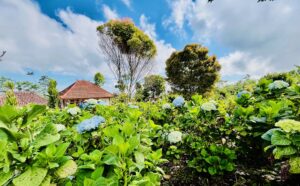
Another crop they grow here is coffee – the famous Bali coffee or (Kopi Bali), and you’ll also find Kopi Luwak, but more on that later. Coffee is grown in this region and around Kintamani, further east, and I was headed to a resort embedded in a coffee plantation – the only one of its kind in Bali. Once I saw this spectacular place, known as Munduk Moding Plantation Nature Resort, I wanted to keep it to myself, let it remain something of a secret. But I was invited to stay here so I could spread the word with fellow Australians and entice them up to the hills, and away from the crowded beaches of the south, for a few days, if not an entire week.
Apart from the altitude and the coffee, the resort is serene, tucked into the hillside, with expansive views to the Bali Sea and at night, the lights of the north coast town, the ‘big smoke’ of Singaraja. One could easily spend days just luxuriating in their villa (there are 36, some with Jacuzzis, others with private pools and a small Jacuzzi) and venturing out for meals by ordering a buggy when needed for the short ride up and over undulating roads to the two restaurants. The only decisions needed would be which treatments to book at the spa (a remedial massage is recommended), and which of the activities from the long menu of activities to try – a yoga class, learning to make Balinese sambal (the spicy accompaniment to every meal), getting up early for a bird-watching tour and which cocktail to order at happy hour, while soaking in the sunset by the pool, all without leaving the resort gates. But those who want to explore further afield can strap on the hiking boots (and pack the swimmers) and head out on a guided jungle trek, bike ride or leisurely drive to nearby waterfalls or Tamblingan Lake for a paddle. I did a bit of everything, although I declined the horse-riding tour to the local village; while I like horses, I have realised the feeling is not mutual, and it’s best to stay out of the saddle.
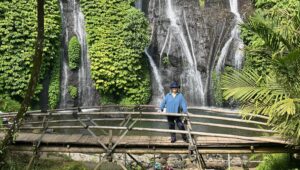
The name Munduk Moding had me scratching my head, but I discovered that Munduk is not only the local region but also a word meaning ‘hill’, while Moding means ‘high view’. Some people come to the resort to escape the crowds and relax, others are nature lovers, others love coffee, but one thing that unites everyone and is perhaps the greatest drawcard of all is the pool – the infinity pool poised on the hillside with a spectacular view behind. So popular is that pool that selfie-seekers have been known to travel far and wide to snap themselves standing there on what looks like the edge of the world — but only at certain times of the day, so that those who are seeking serenity are not disturbed as they enjoy breakfast by the pool. And hats off to that rule. While one of the staff urged me to have a pool edge selfie, I declined – I was worried I might fall in and ruin the vibe and my long dress. I draw the line at bikini selfies!
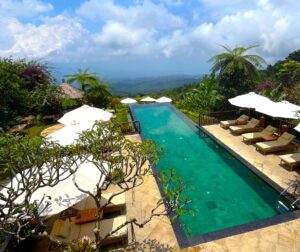
Munduk Moding Retreat is not just a dreamy resort to while away a few days with good food, great service, and attentive staff; it also walks the talk when it comes to caring for the environment and looking after the local community. I took a tour with staff member Elman to hear about the sustainability practices. I heard how all the wastewater is collected into various separate tanks, treated in various ways, filtered with oxygen and eventually used to water the enormous garden and coffee plantation during the dry season. Rainwater and ground spring water are used in the showers and bathroom taps (all drinking water is purchased). The result is that water is not lost but used for other (non-drinking) purposes. This water management and conservation is matched by energy conservation (no mini-bars in the room to cut down on energy, no air-conditioning in most villas – fans and high altitude keep you cool), Jacuzzis are turned off when not used, and very little plastic is used. But what I loved was the onsite Eco-Lab, where staff are employed to collect hard plastics and melt them down to make plastic sheets, which are cut and fashioned into new recycled plastic goods, to both use in the resort and also to sell. Their small onsite shops sell recycled plastic coat hangers, tissue boxes, flowers and even tables and chairs.


As to the community values, the resort asks local school children to bring in plastic bags and waste from home and in return, the kids are given free English lessons and classes in Balinese cultural dance and martial arts. Once a month, the resort organises a clean-up campaign, involving the staff and villagers and children who pick up plastics and waste in the village streets and at the waterfalls and the twin lakes of Lake Tamblingan and Lake Buyan.
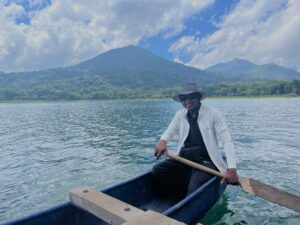
One thing that unites us all is food. So in the name of research, I tried as many dishes from the menu as possible, and dined in my villa on two nights – you can order any item from the menu from either the MMP Restaurant or the Balinese specialty restaurant, a team of two or three delivers the food (and wine if you like) in their buggy and sets it up. I loved their soups (it’s amazing what they can do with humble pumpkin soup by adding a dash of rosemary and oregano) , the lumpia (spring rolls), satays and the salads were a work of art. Once I decided to go Western and ordered Tasmanian salmon with a spicy twist – delicious. On my last night, I struggled through the six-course tasting menu of Balinese delicacies, which I couldn’t finish despite how great it was. Breakfast, included in the price, along with cakes and savouries at afternoon tea, was delicious, especially the juices, rich yoghurt and tropical fruits and the Golden Glow Tea with turmeric, ginger, lime, lemongrass and honey. I thought the prices were reasonable, with dishes such as soup ranging from $7 to the salmon at $36, while an eight-course Indonesian meal suitable for two people (which is a different spread to the Bali six-course tasting menu) was a mere $69. All prices on the menus are in Indonesian rupiahs.
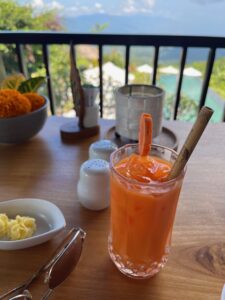
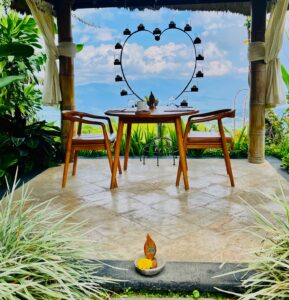
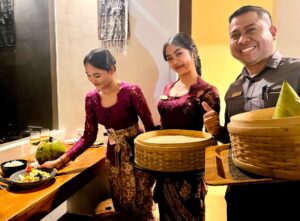
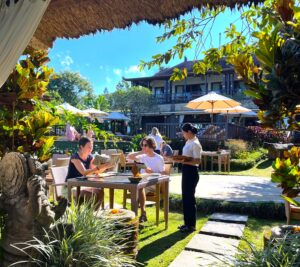


While I could wax lyrical about this place, I will close on a caffeinated note. The Munduk Moding resort began as a coffee plantation about 30 years ago. It was then bought by a Dutch woman who began building villas, one by one. It opened in 2009. Most of the guests come from France, the Netherlands and other European countries, along with the US and Southeast Asia. I did hear a few Australian accents while I was there, and met a couple from New Zealand.
While there are several coffee plantations in the area, this is the only resort built within one. One of the most popular things to do is go for a tour of the plantation with Giri or one of the other staff, who will explain the growing cycle and then take you to the roastery and the tasting room. The resort grows Robusta and some Arabica and has 8000 trees, which is considered a small holding. Coffee has a long history in Bali and Indonesia; it was brought to the islands around 1700 by the Dutch colonialists. Giri told me the volcanic soil was perfect, being richly black and some five metres deep. The plantation is worked by local people who are paid for their work and given coffee as well. While I like to drink coffee, I knew very little about its production, but I learnt a great deal on the hour-long tour and tasting. Munduk produces different styles of coffee from “Fully Washed”, “Natural”, “Honey”, “Robusta” and “Wild Luwak”, which you may have heard of and the controversy around it. If not, let’s just say that producers collect the droppings of the luwak animal (a civet) as this picky creature apparently only eats the best coffee cherries. The digestive process, apparently, produces a great taste. I tasted it 10 years ago in Bali, near Bedegul, and I bought a small package home with me this time, but I haven’t opened it yet. The controversy stems from the practice, employed by some farmers, of caging the luwak and force-feeding it coffee berries and then collecting the ‘poo’. Munduk Moding stresses that they do not condone or employ this practice and only buy the ‘digested’ berries from local farmers who gather them naturally from the forest floor. Giri told me they have a way of testing its authenticity, too! Once the tour was over, I tasted several different styles and must admit I liked the honey blend and Wild Luwak the best. Luwak can sell for around $150 a kilo, and as Giri said, there are incidences of ‘fake Luwak’….so buyer beware. Frankly, I also like the plain Bali Coffee (Bali Kopi) sold in most cafes around the island and offered at the resort at breakfast and afternoon tea, and at any time (for an extra cost) at the onsite cafe, where the plantation beans are used to make Western style coffee drinks as well – cappuccino, latte, short black and other variations. Balinese people prefer their coffee black, and brewed for four minutes.
My last word on the sneaky, finicky little coffee-cherry-eating luwak is that I almost spotted one. I heard a lot of rustling outside my villa one morning, and went out to check. But whatever was there in the bushes (a mini jungle) was scurrying away. They do like to come out at night, but will linger in the shrubbery at early morning or evening.
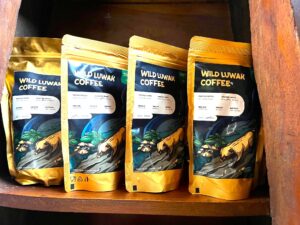

Where is it and when to go:
Munduk Moding Plantation Nature Resort is a good 2.5-hour to 3-hour drive from Denpasar International Airport (I Gusti Ngurah Rai Airport).
My advice is to stay a few nights at a beachside resort first – I prefer the quieter area of Sanur myself and recommend Sumitra Luxury Villas & Resort. And I strongly recommend you stay in the south (at Sanur, Seminyak and other beachside destinations) on the night before you fly out. The traffic into Denpasar from the north can be horrendous. The Munduk resort offers transfers for an extra fee, or you can find another shuttle operator online.
The resort’s high season coincides with our winter (from June to August) and is quite busy as this is when Europeans are on holiday. The weather is mild, and the skies are beautifully clear. The low season (with cheaper prices) coincides with the Australian summer. I found the weather great for most of my six-day stay in October, with the pattern being that it’s beautiful in the morning and tends to rain in the afternoon, and then clears up for a great sunset.
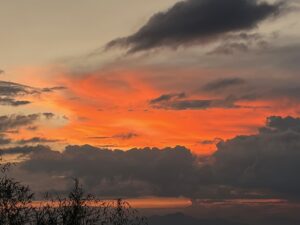
While the resort website prices tend to be set at around A$550 a day for two people in a villa with breakfast and afternoon tea (pool villas are more expensive), I found cheaper deals on booking.com and also the Qantas site. So have a look around.
As for an itinerary, if you want total relaxation, spend a week in Munduk, if you just want a taste, combine it with a few nights on one of the southern beaches, and a few days in the favourite ‘Eat, Pray, Love’ enclave of Ubud – but mind you, Ubud is very busy these days. Munduk is blissfully quiet – there are no beach clubs with thumping doof-doof music, but there are happy hour drinks, great food, fun activities, and that pool.
Back the bikini if you fancy an infinity-edge selfie, but follow the pool rules and own pose in the set hours!
- Disclaimer. I was a guest at Munduk Moding Plantation Nature Resort and spent one night at Sumitra in Sanur. While I was hosted on this trip, after 10 trips to Bali for business and holiday, I have to say this was a unique experience, simply one of a kind. Check out the TripAdvisor comments to see what others are saying. All photos, bar the one of the Jacuzzi and Bar, were taken by me.
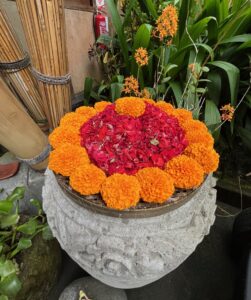


Be the first to comment